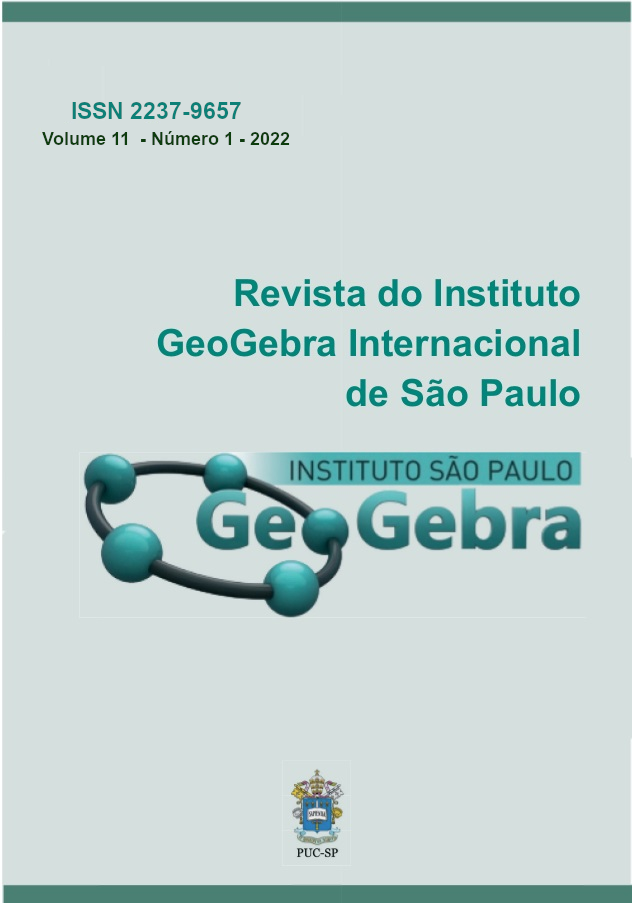Exploring a right triangle property using GeoGebra
DOI:
https://doi.org/10.23925/2237-9657.2022.v11i1p085-100Keywords:
geometric property, Exploration, GeoGebraAbstract
In this article we study and discuss the exploration of a geometric property of the right triangle. In particular, using the GeoGebra dynamic geometric environment, we intend to discover the relationship between the length of the hypotenuse of the right triangle and the length of its median, as well as devise paths for its validation. Four different approaches were taken in the study of the geometric property, highlighting the following aspects from the exploration: 1) the need to define resistant geometric figures so that they preserve the invariant properties of the figures; 2) the particular examples provide very limited evidence for mathematical validation, whereas the generalizable examples allow us to devise paths for the mathematical proof; and 3) the variety of intervening mathematical objects and the connections between them enhance a deeper learning.
References
Alves, M. P., & Fernandes, J. A. (2015). Alterações do programa de matemática do ensino básico português: o caso do tema Organização e Tratamento de Dados. Olh@res, 3(1), 280-305.
Ausubel, D., Novak, J., & Hanesian, H. (1980). Psicologia educacional. Rio de Janeiro: Interamericana.
Courant, R., & Robbins, H. (1996). What is mathematics?: an elementary approach to ideas and methods. New York: Oxford University Press. (Publicação revista por Ian Stewart, original de 1941.)
Crowley, M. L. (1987). The van Hiele Model of the Development of Geometric Thought. In Mary M. Lindquist & Albert P. Shulte (Eds.), Learnig and Teaching Geometry, K-12 (1987 Yearbook, pp. 1-16). Reston: NCTM.
Davis, P. J., & Hersh, R. (1995). A Experiência matemática. Lisboa: Gradiva. (Tradução portuguesa do original de 1981.)
Fernandes, J. A. (2006). Tecnologias no ensino da matemática: Aplicação de um programa de geometria dinâmica no estudo da geometria. Braga: Centro de Formação Prof. Agostinho Manuel da Silva.
Fernandes, J. A., & Vaz, O. (1998). Porquê usar tecnologia nas aulas de matemática? Boletim da SPM, 39, 43-55.
Fischbein, E. (1990). Intuition and information processing in mathematical activity. International Journal of Educational Research, 14, 31-50.
Godino, J. D., Batanero, C., & Font, V. (2007). The onto-semiotic approach to research in mathematics education. ZDM. The International Journal on Mathematics Education, 39(1-2), 127- 135.
Godino, J. D., Giacomone, B., Batanero, C., & Font, V. (2017). Enfoque ontosemiótico de los conocimientos y competencias del profesor de matemáticas. Bolema, 31(57), 90-113.
Junqueira, M. (1996). Exploração de construções geométricas em ambientes computacionais dinâmicos. Quadrante, 5(1), 61-108.
Ministério da Educação e Ciência (2013). Programa e Metas Curriculares Matemática: Ensino básico. Lisboa: Autor.
Ministério da Educação e Ciência (2014). Programa e Metas Curriculares Matemática A: Ensino secundário. Lisboa: Autor.
Poincaré, H. (1932). La valeur de la science. Paris: Ernest Flammarion.
Poincaré, H. (1974). La creación matemática. In M. Kline (Ed.), Matemáticas en el mundo moderno (pp. 14-17). Madrid: Editorial Blume.
Skemp, R. R. (1993). The psychology of learning mathematics. Hillsdale: Lawrence Erlbaum Associates.
Zbiek, R. M. (1995). Reaction to Harvey, Waits, and Demana's article. The Journal of Mathematical Behavior, 14(1), 133-137.
Downloads
Published
How to Cite
Issue
Section
License
Copyright (c) 2022 Revista do Instituto GeoGebra Internacional de São Paulo

This work is licensed under a Creative Commons Attribution 4.0 International License.
Submission, processing, and publication of articles sent to the journal and registration of the DOI at Crossref is free of charge.
Authors retain their copyright and grant the journal the right of first publication of their article, which is simultaneously licensed under a Creative Commons - Attribution 4.0 International license CC BY that allows others to share the article by acknowledging its authorship and initial publication by the journal.
The GeoGebra journal encourages its authors to register their work with information and communication management systems aimed at researchers, such as Academia.edu, Mendeley, ResearchGate, etc.


 10.23925
10.23925
